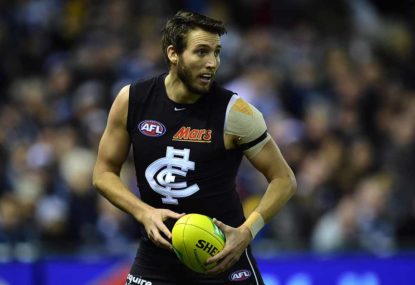This will be the least controversial opinion piece of all time, as there’s not one person in the world who thinks the top eight is a good idea – apart from advertisers, TV networks, and the corporate vampires who run the AFL.
Round 1 is not yet complete but we can safely write off a number of teams already. Carlton are garbage. Essendon are a catastrophe, despite commendable efforts from some of their recycled players. Collingwood are a disgrace, despite once again being talked up for no reason. GWS, Melbourne and Brisbane are also-rans. St Kilda were gallant against Port but for some reason they rushed out of the ground and hopped on the team bus about ten minutes before three-quarter time.
Fremantle are not quite as awful as they appeared to be against the rampant Dogs, but their premiership window slammed shut at Subiaco Oval last September. They’re gone. Finished.
That’s eight teams. North and Adelaide throw up an interesting sort of dilemma. They’re both good sides. Could they go all the way? No. No, they couldn’t.
Gold Coast disposed of a largely hopeless Bombers outfit clinically, but without Ablett – they’re far from the real deal. With him – they’re still not top shelf.
11 teams that are not contenders. Add Richmond to that list for the club’s deep-seeded psychological problems. That’s 12. Yet we know at least two of that list must make the finals.
Why? Maths. And the significance of it? The top eight is a joke.
Furthermore, given the draw is designed to reward last year’s middling teams with an easier run this year – it is too easy for fundamentally pedestrian teams to play finals football.
There’s another problem.
Cast your minds back to late in the season in 1993. With five rounds remaining in the home-and-away season Geelong were wallowing in the lower part of the ladder. And rightly so. Despite having an excellent list, the team had developed the habit of fading away drastically in the second half, and had won only seven of a possible 15 games.
Then something clicked. The Cats pipped Collingwood, then played the ladder leader North Melbourne and won by an astonishing 94 points. Hawthorn replaced North on top of the ladder, so Geelong beat them by 82 the next week. They then dispatched eventual premiers Essendon by 32, then travelled to Perth and beat West Coast by 20 points at the WACA.
Ted Whitten told Gary Ablett Sr after the season: “You were the best team in the competition and didn’t make the finals.” Ablett replied: “If you don’t win enough games during the season, you don’t deserve to be there.” It was one of his rather rare media spots, and he was spot on.
The Cats finished seventh, 12-8, and missed the finals. Under the current top 8 system, they’d have returned to Perth to play the Eagles again in the first week of the finals. In addition to having just beaten West Coast at home, the Cats had done so in 1992 as well, so it was not quite a daunting prospect.
The Cats would then likely have faced either Hawthorn or North Melbourne, two sides they’d recently beaten by an aggregate of 176 points. With their tails up, Geelong may very well have marched to a Premiership from seventh spot, a grotesque and manifestly unfair outcome.
Adelaide in 1997 finished fifth and then fluked its way into a grand final when two terrible umpiring decisions and someone throwing an apple gifted them wins against Geelong and Footscray. They then faced St Kilda, a football club pathologically incapable of success, and the result was a flag from fifth.
It’s not easy to win a premiership from outside the top four, but it isn’t impossible.
The theory is that the mid-range teams who make the eight will quickly be exposed as pretenders and sent packing. It doesn’t always work out that way, because football is a weird thing and sometimes the planets align. An odd bounce here, a random injury there.
The thing is, while a side winning a flag from eighth or seventh would make a cruel mockery of the entire season, it is not that unlikely prospect that is the real downside of a top 8. The downside is that teams don’t have to play good football consistently to make the finals.
The top eight basically allows for a side to play mediocre football for most of the season, scrape unimpressive wins against cellar-dwellers, snatch a couple of upsets against nominally better sides, and then play finals.
I love the finals – even when my side doesn’t make it.
There’s a cruelty to the disregard with which we hold the “minor premiership”. In reality, the side that finishes atop the ladder is the “premier” team, and the side that wins the final the “champion”.
Maybe that’s the soccer in my genes talking, but the fact the only people who care about the minor premiership are the McClelland family is an injustice.
Nevertheless, AFL finals are electric.
September is magic, but don’t let that grease the lens for the close up.
Some will bleat that last year Adelaide (7th) and North (8th) knocked out the Dogs (6th) and Richmond (5th) – in two cracking matches no less.
So let’s go one step further. Last year ninth-placed Geelong had beaten finalists Sydney, Richmond, Adelaide and the Bulldogs during the season, so why not have a top nine? After all that’s half the league and 50% is a pass mark, right? It’s a rubbish argument.
A bit of luck and a good day from sides that finish seventh and eighth doesn’t change the fact that a top six rewards those teams who have put in a good season. Which is just and proper.
POST SCRIPT: A top six also pretty much guarantees Carlton will never play finals again, which is a huge selling point.





























































































